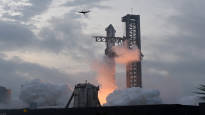The third test flight of SpaceX’s rocket ended on Thursday with the Starship not being able to re-enter the atmosphere, let alone land successfully in the ocean.
Actually Elon Musk’s The third test flight of SpaceX’s giant rocket was very significant, estimates the director of a consulting company focused on space technology Laura Forczyk.
– Now we achieved many goals that have not been achieved in previous flights.
Among them are the use of all 33 rocket engines and the detachment of the Starship. In addition, it was possible to restart some of the engines and open and close the cargo hatches.
– However, the biggest milestone is that it managed to reach orbit, so I think the test flight was successful, Forczyk sums up.
– Apart from some problems, the flight was the most successful so far. It tells us that with such a rocket it is possible to transport heavy loads and also make long distances, such as to the moon. As is the goal of NASA’s Artemis program, it goes hand in hand Matt Shindellcurator of the Air and Space Museum.
During the third and last test flight, the rocket failed to reenter the atmosphere and fall in a controlled manner into the Indian Ocean as planned. Despite these setbacks, SpaceX itself publicly communicated its satisfaction.
– The company’s public image is such that they don’t expect everything to go right, but instead they expect development and improvement over time, explains Shindell.
The return of the rocket to the ground intact is precisely the essential factor for SpaceX’s rocket, as it is designed to be reused.
The ride could hold a hundred tons of goods or more than a hundred passengers
The rocket is much larger than, for example, the space shuttle, and the main idea is that Starship would be able to transport cargo weighing up to a hundred tons to the moon.
With the shuttle capable of carrying a crew of seven, the Starship could carry up to a hundred people or more.
SpaceX’s rocket is described as gigantic.
When standing on its launch pad, it has a length of no less than 121 meters. The thrust of the rocket is also huge, almost twice as powerful as the Saturn V previously used by NASA, which took astronauts to the moon in the 1960s and 70s.
– SpaceX wants to take a person to Mars. In addition, the Ministry of Defense and private customers have shown interest in it, Forczyk reminds.
In addition, Elon Musk’s SpaceX project aims for more cost-effective space travel than has ever been seen.
– Producing and using a rocket is incredibly expensive. In the case of SpaceX’s rocket, the question is whether the costs can be reduced, whether it can even be used as a business, says Shindell.
Interest in SpaceX’s rocket is largely based on the fact that, if successful, it could enable unprecedented space travel and even settlements on the moon.
Before that, one more thing needs to be resolved.
– You have to succeed in bringing the rocket back safely, first into the atmosphere and then into the sea or even onto the surface of the earth. Hopefully we will see this already in the near future, he says.
Matt Shindell considers it a natural continuation that if SpaceX’s technology makes it possible to inhabit the moon, the next target is Mars.
Source: Reuters
